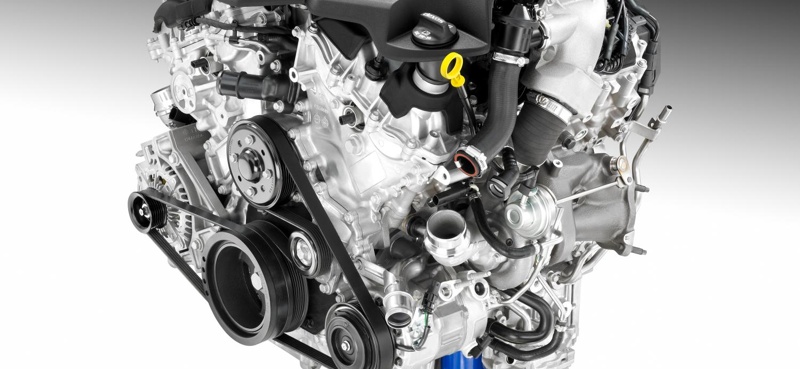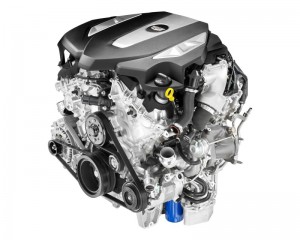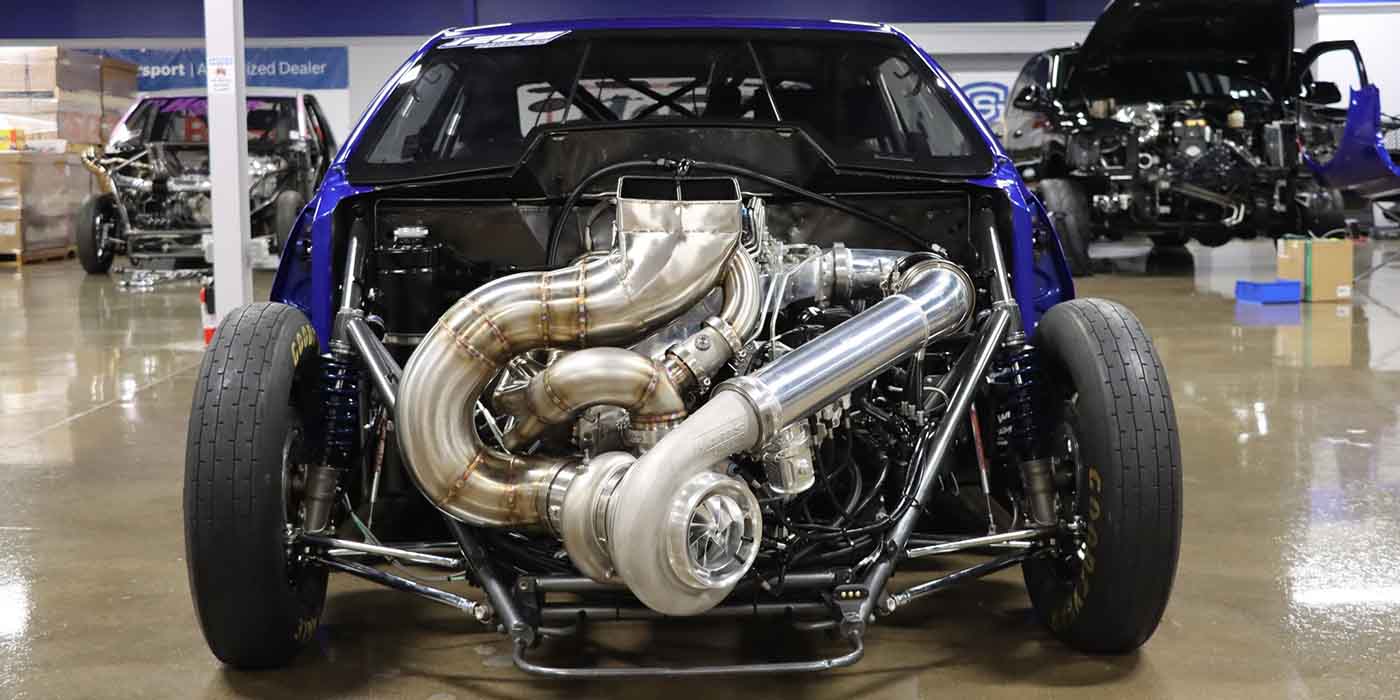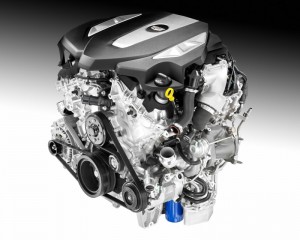
Cadillac has announced a new generation of V6 engines, led by an exclusive Twin Turbo V6 that will be one of the industry’s most advanced six-cylinder gasoline engines. It leverages the latest technology to balance efficiency, performance and refinement in the upcoming, top-of-the-range CT6 luxury performance sedan.
The all-new Cadillac 3.0L Twin Turbo is designed to achieve new thresholds of refinement and specific output for the brand’s new prestige luxury sedan, which makes its world premiere March 31, at the New York International Auto Show. Production begins late this year at General Motors’ Detroit-Hamtramck Assembly Plant.
Peak output is estimated at 400 horsepower and 400 lb-ft of torque, making it one of the most power-dense V6 DOHC engines in the world, developing 133 horsepower per liter.
The 3.0L Twin Turbo is the only six-cylinder engine to combine turbocharging with cylinder deactivation and stop/start technologies to conserve fuel. Cadillac expects the combination to enhance fuel economy by up to an estimated 6 percent. Cylinder deactivation temporarily deactivates two of the cylinders in light-load driving conditions to enhance efficiency and seamlessly reactivates them when the driver demands full power.
With the stop/start system, the 3.0L Twin Turbo is shut down in certain driving conditions such as stop-and-go city driving to reduce fuel consumption, automatically restarting when the driver takes his or her foot off the brake pedal.
The highly-acclaimed Hydra-Matic 8L90 8-speed automatic transmission transfers the 3.0L Twin Turbo’s power to the CT6. Similar to the turbo system in the track-capable Cadillac ATS-V, the new 3.0L Twin Turbo features turbochargers with lightweight, low-inertia titanium-aluminide turbine wheels and an efficient, patented low-volume charge-air cooler, which contribute to optimal boost production and more immediate power delivery.
The advanced, low-inertia turbochargers enable the engine to sustain peak torque from 2,500 rpm to 5,000 rpm, giving it a broad torque curve that is conveyed to the driver through a feeling of responsive, sustained power across the entire rpm band.
The 3.0L Twin Turbo’s estimated 400 horsepower and 133 hp per liter is 27 percent greater than the BMW 740Li’s 3.0L twin-turbo V-6 (315 hp and 105 hp/L) and 29 percent more than the Audi A7’s 3.0L supercharged V-6 (310 hp and 103 hp/L).
Cadillac’s new 3.0L Twin Turbo is part of a new generation of technologically advanced V6 engines, which includes a new version of the award-winning 3.6L naturally aspirated engine employed for years across the brand’s model range. Each features all-new structural and combustion elements designed to complement higher performance and greater efficiency with exceptional quietness and smoothness.
The 3.0L Twin Turbo is up to 5 dB quieter than the Audi 3.0L TFSI engine, while the 3.6L is up to 4 dB quieter than the Infiniti 3.7L V6.
Features shared by the 3.0L Twin Turbo and 3.6L include:
- Stronger, stiffer aluminum block with increased structure in the bulkheads for superior rigidity
- Tough, refined rotating assembly with a stiff forged-steel crankshaft, friction-reducing polymer-coated pistons and strong high-copper-content, sinter-forged connecting rods
- New four-cam phasing system with intermediate park technology that enhances efficiency by enabling late inlet valve closing in certain conditions
- All-new, patented “targeted” cooling system that provides strategic cooling of the engine’s hottest areas while simultaneously fostering faster warm-up, which enhances efficiency
- New cylinder heads that enhance combustion performance and include direct injection and feature integrated exhaust manifolds
- Revised, simplified timing drive system with cushioned chain sprockets contributing to quieter engine operation
- All-new oiling system moves the pump inside the block for quieter operation. The two-stage oil pump also enhances efficiency.
Unique foundation
While the 3.0L Twin Turbo is based on the same, all-new architecture as the naturally aspirated 3.6L V6, it incorporates specific components and features to support the load and cylinder pressure characteristics unique to a forced-induction engine.
Its 86mm bore specification is about 10 percent smaller than the 3.6L, while both engines share an 85.8mm stroke. The smaller bore reduces the size and consequentially the weight of the pistons in the 3.0L Twin Turbo, making the most of the rotating assembly’s geometry to match the quicker rev capability enabled by the low-inertia turbochargers’ quick spool-up.
The smaller bores also allow larger water jackets between the cylinders, which helps maintain optimal combustion temperatures across the rpm band and during sustained high-load, max-boost performance.
Additional features unique to the 3.0L Twin Turbo include:
- Lower 9.8:1 compression ratio vs. 11.5:1 on the naturally aspirated 3.6L
- Extreme duty 44MnSiV6 steel crankshaft forging
- The pistons incorporate a specific steel insert in the top ring land to support the turbocharged engine’s higher cylinder pressures
- Large, 36mm intake valves and 29mm sodium-filled exhaust valves enable the engine to process tremendous airflow
- The valves are held at 19 degrees on the intake side and 16 degrees on the exhaust side vs. the 3.6L’s 18 degrees for the intake and 15 degrees for the exhaust
- Valve spring pre-load tension is increased to manage the greater exhaust pressure during peak load performance
- Hardened AR20 valve seat material on the exhaust side is used for its temperature robustness, while the heads are sealed to the block with multilayer-steel gaskets designed for the pressure of the turbocharging system
- Tuned air inlet and outlet resonators, aluminum cam covers and other features contribute to exceptional quietness and smoothness.
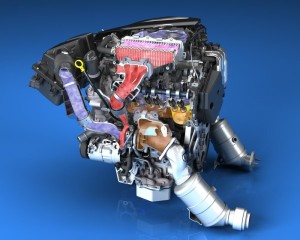 Low-inertia turbochargers and vacuum-actuated wastegates
Low-inertia turbochargers and vacuum-actuated wastegates
The twin, low-inertia turbochargers’ featherweight titanium-aluminide turbines are used with vacuum-actuated wastegate control for precise, responsive torque production. The titanium-aluminide turbines reduce rotating inertial load by more than 50 percent, compared with conventional Inconel turbine wheels. That means less exhaust energy – which spins the turbines – is wasted in stored inertial loads.
In practical terms, that means the relatively small size of the turbochargers and their lightweight turbines foster more immediate “spooling,” which practically eliminates lag, for an immediate feeling of power delivery. They produce up to 18 pounds of boost (125 kPa).
A single, centrally located throttle body atop the engine controls the air charge from both turbochargers after the temperature is reduced in the intercooler. This efficient design also contributes to more immediate torque response, while reducing complexity by eliminating the need for a pair of throttle bodies.
Unique vacuum-actuated wastegates – one per turbocharger – are used with the Twin Turbo for better management of the engine’s boost pressure and subsequent torque response for smoother, more consistent performance. They are independently controlled on each engine bank to balance the compressors’ output to achieve more precise boost pressure response.
The wastegates also work in concert with vacuum-actuated recirculation valves to eliminate co-surge from the turbos – a condition that can result in dynamic flow reversal, such as the moment immediately after the throttle closes. This overall system integration contributes to the engine’s smoother, more consistent feeling of performance.
Patented low-volume charge-air cooling
Cadillac’s patented, manifold-integrated water-to-air charge cooling system also contributes to more immediate torque response, because the compressors blow through very short pipes up to the intercooler.
With no circuitous heat-exchanger tubing, there is essentially no lag with the response of the turbochargers. Airflow routing volume is reduced by 60 percent when compared with a conventional design that features a remotely mounted heat exchanger.
The charge-cooling heat exchangers lower the air charge temperature by more than 200 degrees F (94 C), packing the combustion chambers with cooler, denser air for greater power. Also, the air cooler system achieves more than 80 percent cooling efficiency with only about 1 psi (7 kPa) flow restriction at peak power, which contributes to fast torque production.
Manufacturing
Both of Cadillac’s new V6 engines will be produced at GM’s Romulus Powertrain Operations assembly facility, near Detroit, which received a $540-million investment to build the next-generation V6 engines.
Source: Cadillac

